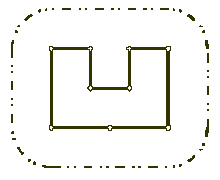poj 1113 Wall 计算几何 凸包 Graham扫描
来源:互联网 发布:krystal kai 分手 知乎 编辑:程序博客网 时间:2024/05/19 14:34
Wall
Time Limit: 1000MS Memory Limit: 10000KTotal Submissions: 35684 Accepted: 12177
Description
Once upon a time there was a greedy King who ordered his chief Architect to build a wall around the King's castle. The King was so greedy, that he would not listen to his Architect's proposals to build a beautiful brick wall with a perfect shape and nice tall towers. Instead, he ordered to build the wall around the whole castle using the least amount of stone and labor, but demanded that the wall should not come closer to the castle than a certain distance. If the King finds that the Architect has used more resources to build the wall than it was absolutely necessary to satisfy those requirements, then the Architect will loose his head. Moreover, he demanded Architect to introduce at once a plan of the wall listing the exact amount of resources that are needed to build the wall.

Your task is to help poor Architect to save his head, by writing a program that will find the minimum possible length of the wall that he could build around the castle to satisfy King's requirements.
The task is somewhat simplified by the fact, that the King's castle has a polygonal shape and is situated on a flat ground. The Architect has already established a Cartesian coordinate system and has precisely measured the coordinates of all castle's vertices in feet.

Your task is to help poor Architect to save his head, by writing a program that will find the minimum possible length of the wall that he could build around the castle to satisfy King's requirements.
The task is somewhat simplified by the fact, that the King's castle has a polygonal shape and is situated on a flat ground. The Architect has already established a Cartesian coordinate system and has precisely measured the coordinates of all castle's vertices in feet.
Input
The first line of the input file contains two integer numbers N and L separated by a space. N (3 <= N <= 1000) is the number of vertices in the King's castle, and L (1 <= L <= 1000) is the minimal number of feet that King allows for the wall to come close to the castle.
Next N lines describe coordinates of castle's vertices in a clockwise order. Each line contains two integer numbers Xi and Yi separated by a space (-10000 <= Xi, Yi <= 10000) that represent the coordinates of ith vertex. All vertices are different and the sides of the castle do not intersect anywhere except for vertices.
Next N lines describe coordinates of castle's vertices in a clockwise order. Each line contains two integer numbers Xi and Yi separated by a space (-10000 <= Xi, Yi <= 10000) that represent the coordinates of ith vertex. All vertices are different and the sides of the castle do not intersect anywhere except for vertices.
Output
Write to the output file the single number that represents the minimal possible length of the wall in feet that could be built around the castle to satisfy King's requirements. You must present the integer number of feet to the King, because the floating numbers are not invented yet. However, you must round the result in such a way, that it is accurate to 8 inches (1 foot is equal to 12 inches), since the King will not tolerate larger error in the estimates.
Sample Input
9 100200 400300 400300 300400 300400 400500 400500 200350 200200 200
Sample Output
1628
题意:
给定多边形城堡的n个顶点,绕城堡外面建一个围墙,围住所有点,并且墙与所有点的距离至少为L,求这个墙最小的长度。
解题思路:
城堡围墙长度最小值 = 城堡顶点坐标构成的散点集的凸包总边长 + 半径为L的圆周长
#include <cstdio> #include <string> #include <iostream>#include <cstring>#include <cctype>#include <algorithm>#include <functional>#include <cstdlib>#include <list>#include <utility>#include <vector>#include <bitset>#include <cmath>using namespace std;typedef long long LL;const int maxn = 1e3 + 5;const double EPS = 1e-6;const double PI = acos(-1.0);//考虑误差的加法运算double Add(double a, double b) { if (abs(a + b) < EPS * (abs(a) + abs(b))) return 0; return a + b;}//二维向量结构体struct Point2 { double x, y; Point2() {} Point2(double x, double y) : x(x), y(y) {} Point2 operator+(const Point2& p) const { return Point2(Add(x, p.x), Add(y, p.y)); } Point2 operator-(const Point2& p) const { return Point2(Add(x, -p.x), Add(y, -p.y)); } Point2 operator*(double d) { return Point2(x*d, y*d); } //內积 double Dot(const Point2& p) const { return Add(x*p.x, y*p.y); } //外积 double Det(const Point2& p) const { return Add(x*p.y, -y*p.x); }};bool CmpXY(const Point2& p, const Point2& q) { if (p.x != q.x) return p.x < q.x; return p.y < q.y;}//求凸包vector<Point2> GrahamScan(Point2* ps, int n) { sort(ps, ps + n, CmpXY); int k = 0; //凸包的顶点数 vector<Point2> qs(n << 1); //构造凸包的下侧 for (int i = 0; i < n; ++i) { while (k > 1 && (qs[k - 1] - qs[k - 2]).Det(ps[i] - qs[k - 1]) <= 0) --k; qs[k++] = ps[i]; } //构造凸包上侧 for (int i = n - 2, t = k; i >= 0; --i) { while (k > t && (qs[k - 1] - qs[k - 2]).Det(ps[i] - qs[k - 1]) <= 0) --k; qs[k++] = ps[i]; } qs.resize(k - 1); return qs;}//两点间距离double Dist(const Point2& p, const Point2& q) { return sqrt((p - q).Dot(p - q));}double Solve(Point2* p, int n, int r) { vector<Point2> convexHull = GrahamScan(p, n); double len = Dist(*convexHull.begin(), *(convexHull.end() - 1)); for (int i = 1; i < convexHull.size(); ++i) { len += Dist(convexHull[i], convexHull[i - 1]); } len += PI * 2 * r; return len;}int main() {#ifdef NIGHT_13 freopen("in.txt", "r", stdin);#endif std::ios::sync_with_stdio(false); int n, r; Point2 p[maxn]; while (scanf("%d%d", &n, &r) == 2) { for (int i = 0; i < n; ++i) { scanf("%lf%lf", &p[i].x, &p[i].y); } printf("%.0f\n", Solve(p, n, r)); } return 0;} 0 0
- poj 1113 Wall 计算几何 凸包 Graham扫描
- 【计算几何初步-凸包-Graham扫描法-极角序】【HDU1348】 WALL
- POJ 1113 WALL(凸包-计算几何)
- Poj 1113 Wall (凸包Graham)
- POJ 1113 && HDU 1348 Wall (凸包周长 graham扫描法)
- 计算几何之凸包----Graham扫描法
- 计算几何 : 凸包学习笔记 --- Graham 扫描法
- poj 1113 Wall(Graham扫描法求凸包)
- POJ 1113 Wall (计算几何-凸包)
- Poj 1113 Wall (凸包Graham水平序)
- POJ 1113-Wall(凸包-Graham算法)
- 【凸包 Graham法 点集排序】poj 1113 Wall
- POJ1113 Wall 凸包(Graham扫描法)
- 计算几何:极角排序(poj 2007 Scrambled Polygon)与简单凸包(poj 1113 Wall)
- POJ 1113 Wall 凸包求边长 Graham扫描法
- 计算几何 graham 最大凸包
- 最小凸包算法(Convex Hull)(1)-Graham扫描法 -计算几何-算法导论
- [计算几何-凸包]pku1113-Wall
- 如何use @string resource
- 倒排索引
- Sublime Text3 常用快捷键必看
- Android开发工具类之FileUtils,ImageUtils
- Android五大存储方式之数据库升级篇
- poj 1113 Wall 计算几何 凸包 Graham扫描
- UVA 1354 Mobile Computing 枚举二叉树 *
- Mac系统生成publicKey(ssh .pub key)
- iOS开发运用block时何时会导致内存泄露问题???
- luogu试练场の简单的模拟
- TODO:MongoDB MySQL数据库备份
- [codevs3914] 昆虫繁殖
- AngularJS 模块与控制器
- 使用POI实现上传ecxel文件,并读取其中数据并存入数据库


